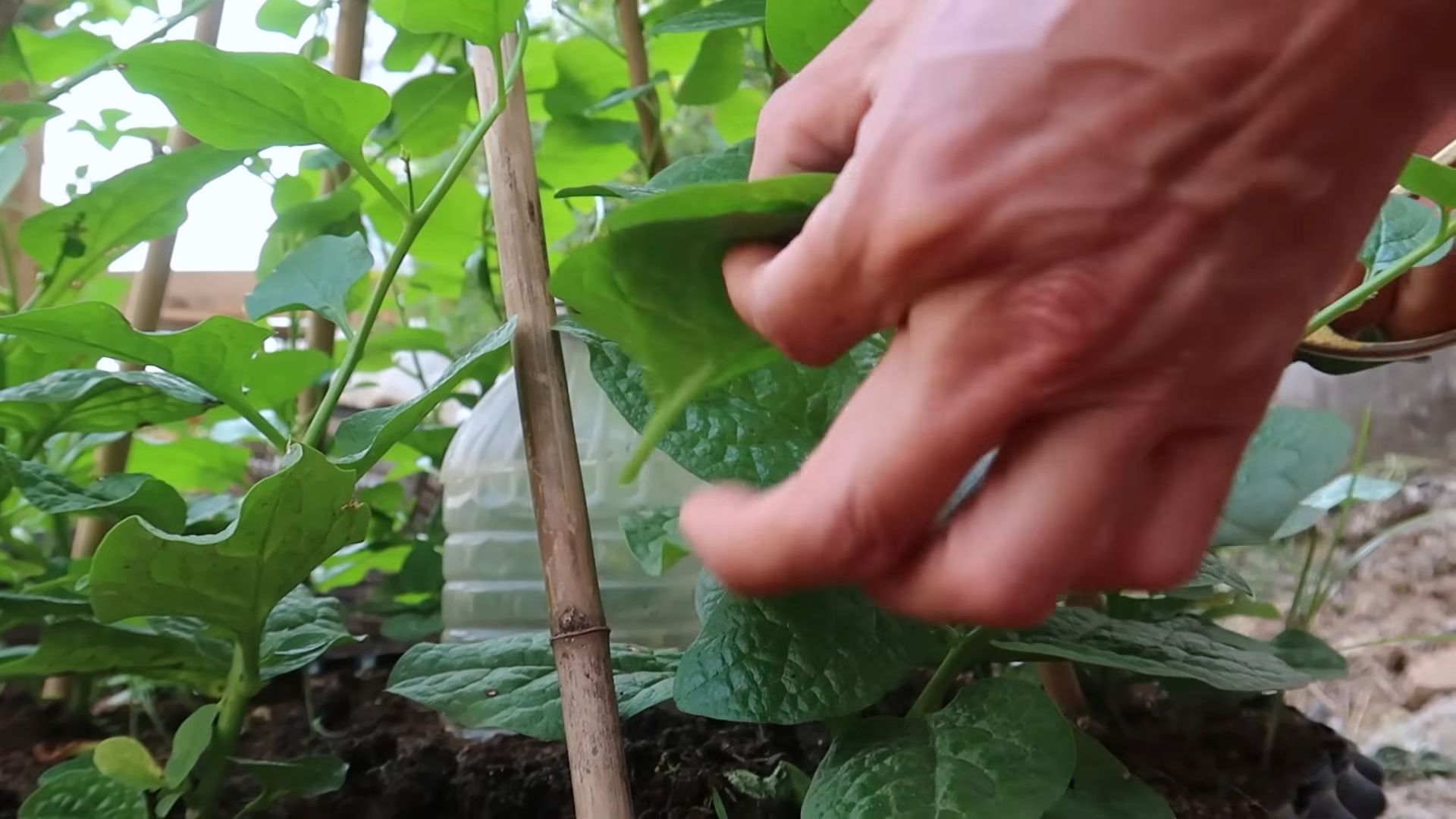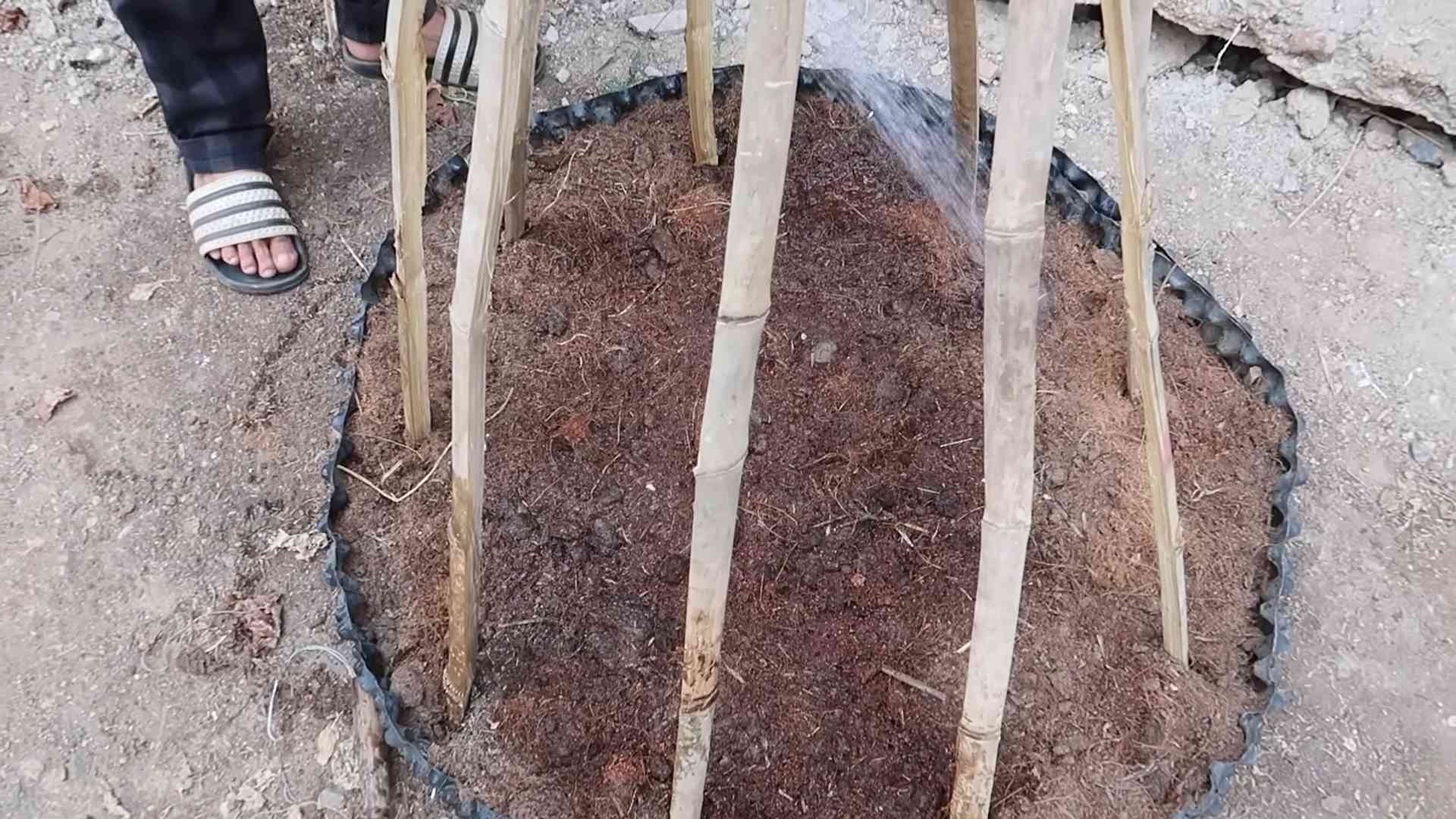Growing Spinach at Home can feel like a daunting task, conjuring images of sprawling farms and complicated machinery. But what if I told you that fresh, vibrant spinach is well within your reach, even if you only have a small balcony or a sunny windowsill? Forget those limp, pre-packaged greens from the supermarket! This article is your ultimate guide to unlocking the secrets of cultivating your own delicious spinach, right in the comfort of your home.
Spinach, a leafy green powerhouse, boasts a rich history dating back over 2,000 years to ancient Persia. It wasn’t until the 14th century that it made its way to Europe, quickly becoming a staple in cuisines across the continent. Beyond its culinary appeal, spinach has long been celebrated for its nutritional benefits, packed with vitamins, minerals, and antioxidants. Think Popeye and his incredible strength!
Why should you embark on this home gardening adventure? Well, for starters, you’ll have access to the freshest, most flavorful spinach imaginable. Plus, you’ll know exactly where your food is coming from and what’s gone into growing it – no harmful pesticides or questionable practices. But more than that, growing spinach at home is incredibly rewarding. There’s something truly special about nurturing a plant from seed to harvest, and enjoying the fruits (or rather, leaves!) of your labor. So, let’s dive in and discover the simple yet effective DIY tricks and hacks that will transform you into a spinach-growing pro!

Growing Spinach at Home: A Beginner’s Guide
Hey there, fellow gardening enthusiasts! I’m so excited to share my experience with growing spinach at home. It’s surprisingly easy, incredibly rewarding, and nothing beats the taste of fresh, homegrown spinach in your salads, smoothies, or cooked dishes. This guide will walk you through everything you need to know, from choosing the right variety to harvesting your leafy greens. Let’s get started!
Choosing the Right Spinach Variety
Before you even think about planting, you need to pick the right spinach variety for your climate and growing conditions. Here’s a quick rundown of some popular choices:
- Savoy Spinach: This type has crinkled, curly leaves and a slightly stronger flavor. It’s cold-hardy and great for fall and winter harvests. Examples include ‘Bloomsdale’ and ‘Melody’.
- Semi-Savoy Spinach: A good compromise between Savoy and Smooth-leaf, offering some texture but easier to clean. ‘Tyee’ is a popular choice.
- Smooth-Leaf Spinach: These varieties have flat, smooth leaves that are easy to wash and have a milder flavor. They’re often preferred for processing and salads. ‘Space’ and ‘Giant Nobel’ are excellent options.
- Heat-Resistant Spinach: If you live in a warmer climate, look for varieties specifically bred to tolerate heat, like ‘Malabar’ or ‘New Zealand’ spinach (though technically not true spinach, they offer a similar taste and texture).
Consider your local climate and personal preferences when making your choice. I personally love ‘Bloomsdale’ for its robust flavor and cold hardiness, but I also grow ‘Space’ for its ease of cleaning.
Preparing Your Planting Area
Spinach thrives in well-drained soil that’s rich in organic matter. Here’s how to get your planting area ready:
- Sunlight: Spinach needs at least 3-4 hours of direct sunlight per day. In hotter climates, some afternoon shade is beneficial to prevent bolting (going to seed prematurely).
- Soil: The ideal soil pH for spinach is between 6.5 and 7.0. Amend your soil with compost or well-rotted manure to improve drainage and fertility. If you’re unsure about your soil pH, you can purchase a soil testing kit at your local garden center.
- Drainage: Spinach doesn’t like soggy soil, so make sure your planting area has good drainage. If you have heavy clay soil, consider adding sand or perlite to improve drainage.
- Weed Removal: Clear the area of any weeds and debris. Weeds compete with spinach for nutrients and water, so it’s important to start with a clean slate.
Planting Spinach Seeds
Now for the fun part – planting! You can start spinach seeds indoors or directly sow them in your garden. I prefer direct sowing because it’s less work and spinach seedlings don’t always transplant well.
- Timing: Spinach is a cool-season crop, so plant it in early spring or late summer/early fall. In my area (zone 6), I plant in March/April for a spring harvest and again in August/September for a fall harvest. Check your local planting calendar for the best dates in your region.
- Sowing Seeds: Sow seeds about ½ inch deep and 1 inch apart in rows that are 12-18 inches apart. You can also broadcast the seeds and thin them later.
- Watering: Gently water the soil after planting. Keep the soil consistently moist until the seeds germinate.
- Germination: Spinach seeds typically germinate in 5-10 days, depending on the soil temperature.
Caring for Your Spinach Plants
Once your spinach seedlings emerge, it’s important to provide them with proper care to ensure a healthy and abundant harvest.
- Thinning: When the seedlings are about 2 inches tall, thin them to 3-6 inches apart. This will give them enough room to grow and prevent overcrowding. You can eat the thinned seedlings in salads!
- Watering: Water regularly, especially during dry periods. Spinach needs consistent moisture to thrive. Aim for about 1 inch of water per week.
- Fertilizing: Spinach is a heavy feeder, so fertilize it every 2-3 weeks with a balanced organic fertilizer. I like to use fish emulsion or compost tea.
- Weed Control: Keep the area around your spinach plants free of weeds. Hand-pull weeds regularly or use a hoe to cultivate the soil.
- Pest and Disease Control: Spinach is generally pest-resistant, but it can be susceptible to aphids, flea beetles, and leaf miners. Inspect your plants regularly and take action if you see any signs of infestation. You can use insecticidal soap or neem oil to control these pests. Downy mildew is a common fungal disease that can affect spinach. To prevent downy mildew, provide good air circulation and avoid overhead watering.
Harvesting Your Spinach
The best part! You can start harvesting spinach leaves when they are about 4-6 inches long.
- Harvesting Method: You can harvest the entire plant at once by cutting it off at the base, or you can harvest individual leaves as needed. I prefer to harvest individual leaves because it allows the plant to continue producing.
- Harvesting Time: Harvest spinach in the morning, when the leaves are crisp and cool.
- Storage: Store spinach in the refrigerator in a plastic bag or container. It will keep for about a week.
Preventing Bolting
Bolting is when spinach plants send up a flower stalk and the leaves become bitter. This is usually triggered by hot weather or long days. Here are some tips to prevent bolting:
- Choose Heat-Resistant Varieties: As mentioned earlier, some spinach varieties are more heat-tolerant than others.
- Provide Shade: In hot climates, provide afternoon shade to your spinach plants. You can use shade cloth or plant them near taller plants that will provide some protection from the sun.
- Water Regularly: Keep the soil consistently moist to prevent stress.
- Harvest Regularly: Harvesting leaves regularly encourages the plant to keep producing and delays bolting.
Succession Planting
To enjoy a continuous harvest of spinach throughout the growing season, practice succession planting. This means planting new seeds every 2-3 weeks. This will ensure that you always have a fresh supply of spinach.
Troubleshooting Common Problems
Even with the best care, you might encounter some problems when growing spinach. Here are some common issues and how to address them:
- Yellowing Leaves: This can be caused by nutrient deficiencies, overwatering, or underwatering. Check your soil pH and fertilize if necessary. Make sure the soil is well-drained and water regularly.
- Stunted Growth: This can be caused by poor soil, lack of sunlight, or pest infestations. Amend your soil with compost, provide adequate sunlight, and control pests.
- Bitter Taste: This is usually a sign of bolting. Harvest the leaves before they become too bitter.
Enjoying Your Homegrown Spinach
Now that you’ve harvested your spinach, it’s time to enjoy it! Here are some of my favorite ways to use homegrown spinach:
- Salads: Add fresh spinach to your favorite salads for a boost of nutrients.
- Smoothies: Blend spinach into your smoothies for a healthy and delicious drink.
- Sautéed Spinach: Sauté spinach with garlic and olive oil for a simple and flavorful side dish.
- Spinach Dip: Make a creamy spinach dip for parties or gatherings.
- Spinach Pie: Use spinach in savory pies and quiches.
Growing spinach at home is a rewarding experience that provides you with fresh, healthy greens. With a little bit of planning and care, you can enjoy a bountiful harvest of spinach throughout the growing season. Happy gardening!

Conclusion
So, there you have it! Growing spinach at home is not only achievable, but it’s also incredibly rewarding. From the vibrant green leaves gracing your garden to the fresh, nutrient-packed goodness enriching your meals, the benefits are undeniable. This isn’t just about saving a few dollars at the grocery store; it’s about connecting with your food, understanding its journey from seed to plate, and enjoying the unparalleled flavor of homegrown produce.
Why is this DIY trick a must-try? Because it empowers you to control the quality of your spinach, ensuring it’s free from harmful pesticides and bursting with vitamins. Store-bought spinach, while convenient, often lacks the robust flavor and crisp texture of freshly harvested leaves. Plus, the satisfaction of nurturing a plant from a tiny seed to a thriving source of food is a feeling that’s hard to beat.
But the fun doesn’t stop there! Feel free to experiment with different varieties of spinach. Try ‘Bloomsdale Long Standing’ for its heat tolerance, or ‘Winter Bloomsdale’ for its resilience in colder climates. You can also explore growing spinach in containers if you have limited garden space. A sunny balcony or patio can easily accommodate a few pots of spinach, bringing a touch of green to even the smallest urban dwelling.
Consider companion planting to maximize your garden’s potential. Spinach thrives alongside plants like radishes, lettuce, and strawberries. These companions can help deter pests and improve the overall health of your spinach plants. You can also use your homegrown spinach in a variety of dishes. From salads and smoothies to soups and stir-fries, the possibilities are endless. Get creative in the kitchen and discover new ways to enjoy the fruits (or rather, the leaves!) of your labor.
Don’t be intimidated if you’re a beginner gardener. Growing spinach at home is a forgiving process, and even small successes can be incredibly motivating. Start with a small patch or a single container, and gradually expand your growing area as you gain confidence. Remember to pay attention to your plants’ needs, providing them with adequate sunlight, water, and nutrients.
We wholeheartedly encourage you to give this DIY trick a try. Embrace the challenge, learn from your mistakes, and celebrate your successes. And most importantly, share your experience with us! We’d love to hear about your spinach-growing journey, your favorite varieties, and your creative culinary creations. Post photos of your thriving spinach plants, share your tips and tricks, and inspire others to embark on their own homegrown spinach adventures. Let’s create a community of spinach enthusiasts, sharing our knowledge and passion for this amazing leafy green. So, grab your seeds, prepare your soil, and get ready to experience the joy of growing spinach at home! You won’t regret it.
Frequently Asked Questions (FAQs)
What is the best time of year to plant spinach?
Spinach is a cool-season crop, meaning it thrives in cooler temperatures. The best time to plant spinach is typically in early spring or early fall. For a spring crop, sow seeds as soon as the ground can be worked, usually a few weeks before the last expected frost. For a fall crop, plant seeds about 6-8 weeks before the first expected frost. In warmer climates, you can even grow spinach throughout the winter, provided you offer some protection from extreme cold. Avoid planting spinach during the heat of summer, as high temperatures can cause it to bolt (go to seed) prematurely, resulting in bitter-tasting leaves.
How much sunlight does spinach need?
Spinach needs at least 3-6 hours of sunlight per day to grow well. While it can tolerate some shade, especially in warmer climates, insufficient sunlight can lead to leggy growth and reduced yields. Choose a planting location that receives morning sun and afternoon shade, especially during the hotter months. If you’re growing spinach indoors, use grow lights to supplement natural sunlight and ensure your plants receive adequate illumination.
What kind of soil is best for growing spinach?
Spinach prefers well-drained soil that is rich in organic matter. The ideal soil pH is between 6.5 and 7.0. Before planting, amend your soil with compost or other organic matter to improve its fertility and drainage. Avoid heavy clay soils, as they can become waterlogged and inhibit root growth. If you have clay soil, consider growing spinach in raised beds or containers filled with a well-draining potting mix.
How often should I water my spinach plants?
Spinach needs consistent moisture to thrive. Water your plants regularly, especially during dry periods. Aim to keep the soil consistently moist but not waterlogged. Overwatering can lead to root rot, while underwatering can cause the leaves to wilt and become bitter. Check the soil moisture regularly by sticking your finger into the soil about an inch deep. If the soil feels dry, it’s time to water.
How do I prevent spinach from bolting?
Bolting is a common problem with spinach, especially during hot weather. To prevent bolting, choose bolt-resistant varieties, plant spinach in a location that receives afternoon shade, and water regularly to keep the soil cool and moist. You can also mulch around your plants to help retain moisture and regulate soil temperature. Harvest your spinach regularly, as this can also help prevent bolting.
What are some common pests and diseases that affect spinach?
Spinach is susceptible to several pests and diseases, including aphids, leaf miners, flea beetles, and downy mildew. To prevent pest and disease problems, practice good garden hygiene, such as removing weeds and debris from around your plants. Inspect your plants regularly for signs of pests or diseases, and take action promptly if you notice any problems. You can use organic pest control methods, such as insecticidal soap or neem oil, to control aphids and other pests. To prevent downy mildew, choose disease-resistant varieties and ensure good air circulation around your plants.
When and how should I harvest my spinach?
You can begin harvesting spinach leaves as soon as they are large enough to eat, usually about 4-6 weeks after planting. Harvest the outer leaves first, leaving the inner leaves to continue growing. You can either cut the leaves with scissors or gently pluck them from the plant. Harvest spinach in the morning, when the leaves are crisp and cool. Avoid harvesting during the heat of the day, as the leaves can wilt quickly.
Can I grow spinach in containers?
Yes, spinach grows well in containers. Choose a container that is at least 6 inches deep and has drainage holes. Fill the container with a well-draining potting mix and plant your spinach seeds or seedlings. Place the container in a location that receives at least 3-6 hours of sunlight per day. Water regularly and fertilize every few weeks with a balanced fertilizer.
How do I store harvested spinach?
To store harvested spinach, wash the leaves thoroughly and pat them dry with a paper towel. Store the spinach in a plastic bag or container in the refrigerator. Spinach is best used within a few days of harvesting, but it can last up to a week if stored properly.
What are the nutritional benefits of spinach?
Spinach is a nutritional powerhouse, packed with vitamins, minerals, and antioxidants. It is an excellent source of vitamins A, C, and K, as well as folate, iron, and calcium. Spinach is also low in calories and high in fiber, making it a healthy and delicious addition to any diet.




Leave a Comment